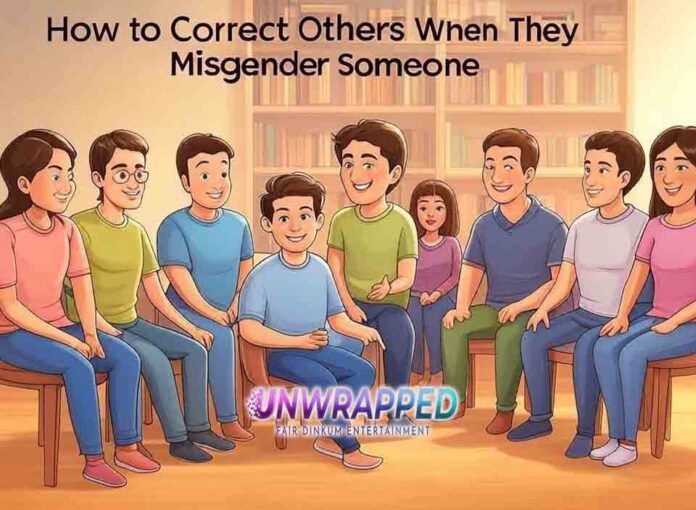In today’s diverse society, understanding and respecting individuals’ gender identities is paramount. Misgendering—referring to someone using incorrect pronouns or gendered terms—can cause significant emotional distress and perpetuate feelings of invalidation. As allies and advocates for inclusivity, it’s crucial to address misgendering when it occurs, fostering environments where everyone feels seen and respected.
Correcting someone who has misgendered another person can be delicate. It requires a balance of assertiveness and empathy, ensuring the correction educates without alienating. This guide offers comprehensive strategies to navigate such situations effectively, promoting respectful communication and reinforcing the importance of gender inclusivity.
Understanding Misgendering
Misgendering involves using language that does not align with a person’s affirmed gender identity. This can manifest through incorrect pronouns, names, or honorifics. The impact of misgendering extends beyond mere words; it can lead to feelings of invisibility and psychological distress. As highlighted by Harvard Health, consistent misgendering can contribute to mental health challenges and a sense of exclusion.
Another Must-Read: How to Deal With People: A Masterclass in Building Better Relationships
The Importance of Correcting Misgendering
Addressing misgendering is not just about rectifying a linguistic error; it’s about affirming an individual’s identity and dignity. When misgendering goes unchallenged, it can perpetuate harmful norms and signal tacit approval of disrespect. By intervening, allies demonstrate solidarity and contribute to a culture of inclusivity.
Effective Strategies for Correcting Misgendering
Immediate and Respectful Correction
When witnessing misgendering, a prompt and polite correction can be effective. For instance, saying, “Actually, Alex uses they/them pronouns,” gently informs the speaker without causing embarrassment. This approach mirrors the A.C.M. method—Apologize, Correct, Move on—recommended by Verywell Mind, emphasizing brevity and respect.
Private Conversations for Sensitive Situations
In cases where public correction may cause discomfort, addressing the issue privately is advisable. Engaging the individual in a one-on-one conversation allows for a more in-depth discussion about the importance of correct pronoun usage, fostering understanding without public scrutiny.
Modeling Inclusive Language
Demonstrating the use of correct pronouns and inclusive language sets a positive example. Incorporating pronouns in introductions and communications normalizes the practice and encourages others to follow suit. As noted by Harvard Health, such actions signal awareness and respect for diverse gender identities.
Educational Interventions
Providing resources or sharing articles on gender inclusivity can be a non-confrontational way to educate others. This approach allows individuals to learn at their own pace and fosters a deeper understanding of the significance of respecting gender identities.
Challenges in Correcting Misgendering
Addressing misgendering can sometimes lead to defensive reactions or discomfort. It’s essential to approach such situations with empathy, focusing on the impact of the words rather than assigning blame. Emphasizing the importance of respect and inclusivity can help mitigate resistance and encourage openness to change.
See Also: How to Collaborate with Influencers on a Budget
Creating Inclusive Environments
Beyond individual corrections, fostering environments that prioritize inclusivity is crucial. This includes:
Implementing Inclusive Policies: Organizations should establish clear guidelines that promote the use of correct pronouns and address misgendering.
Providing Training and Resources: Educational programs on gender diversity can equip individuals with the knowledge and tools to engage respectfully.
Encouraging Open Dialogue: Creating spaces where discussions about gender identity are welcomed and respected encourages continuous learning and empathy.
Call to Action
Promoting gender inclusivity is a collective responsibility. By actively correcting misgendering and fostering respectful communication, we contribute to a more inclusive and compassionate society. Share this guide with your network, initiate conversations about gender respect, and commit to continuous learning and advocacy.
Conclusion
Addressing misgendering is a vital step toward affirming individuals’ identities and fostering inclusive communities. Through immediate, respectful corrections and ongoing education, we can challenge harmful norms and promote understanding. It’s not merely about correcting language; it’s about upholding the dignity and humanity of every person.
As society continues to evolve, embracing diversity and inclusivity becomes increasingly important. By committing to respectful communication and standing against misgendering, we pave the way for a more empathetic and equitable world.
People Also Love: How to Make a Girl Feel Safe and Comfortable Around You










